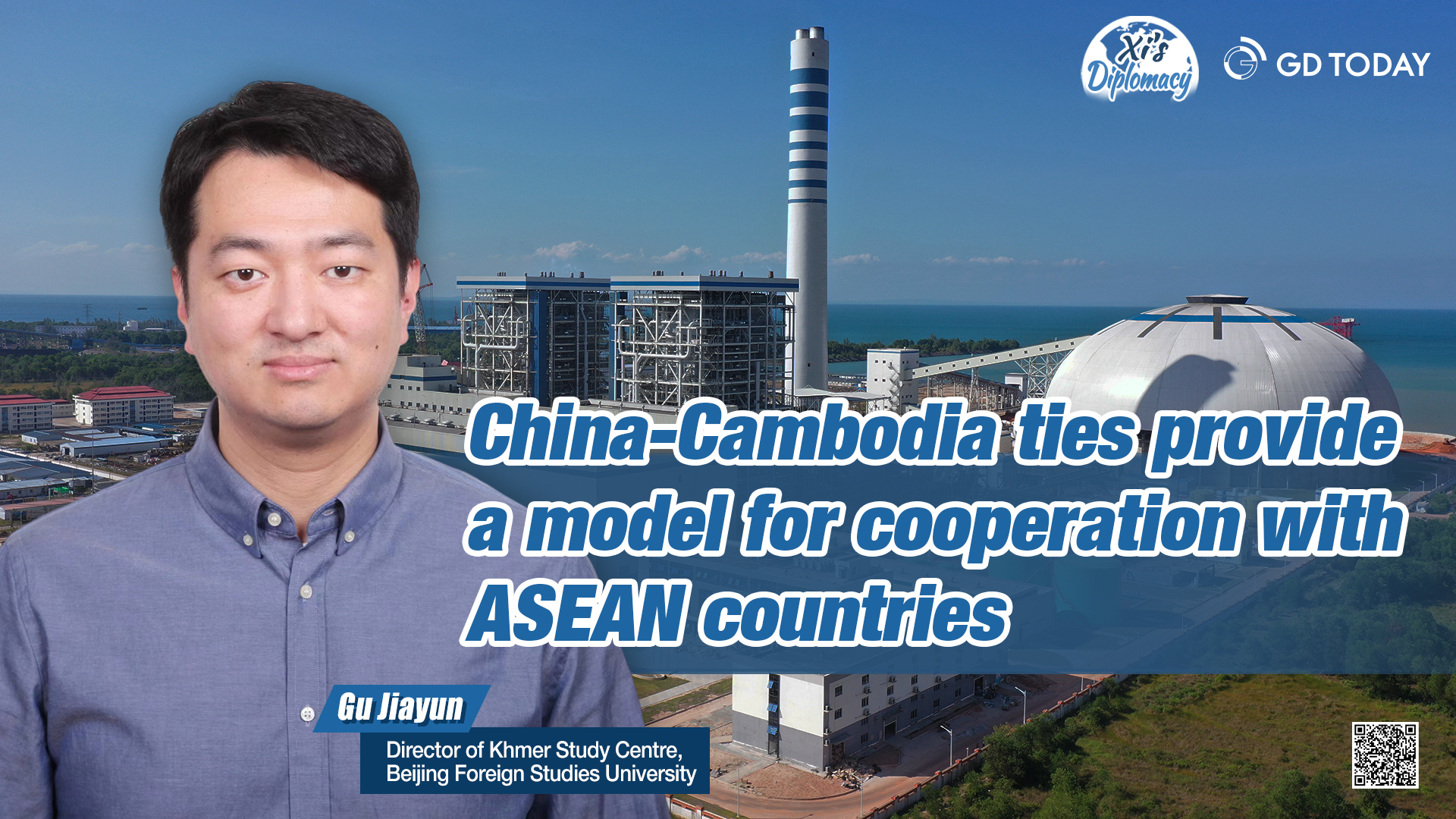Chinese President Xi Jinping met with Prime Minister of the Kingdom of Cambodia Hun Sen at the Diaoyutai State Guesthouse in Beijing on Feb. 10.
"It gives me great pleasure to work with you to realize our three-year appointment and open a new era of building a China-Cambodia community with a shared future at the start of spring," Xi said in the meeting.
"Prime Minister Hun Sen's visit reflects the strong will of China and Cambodia to strengthen high-level strategic communication." Gu Jiayun, Director of Khmer Study Centre, Beijing Foreign Studies University told GDToday reporter.

China-Cambodia cooperation brings more possibilities to regional ties
Three years ago, when the COVID-19 outbreak in China was going through the worst period, Hun Sen was the first world leader to have visited China, which has given China important support. Three years later, when China enters new phase of COVID response, Hun Sen visited China again to express his trust and welcome to China's COVID-19 policy adjustment.
"For a long time, China-Cambodia economic and trade cooperation has boosted Cambodia's economic development. Taking agriculture as an example, China is providing a consumer market for more and more Cambodian agricultural products," said Gu Jiayun.
According to The Phnom Penh Post, Hun Sen revealed that besides the Phnom Penh-Sihanoukville Expressway linking the capital Phnom Penh to the largest seaport province of Preah Sihanouk, more new projects will also be discussed during the visit.
Before the outbreak of COVID-19, China was the largest source of foreign tourists to Cambodia. "As China optimized its COVID-19 policy, some cooperation affected by the pandemic will recover quickly, for example, tourism and student exchanges. It will also stimulate an increase in the variety and quantity of Cambodian goods entering the Chinese market," said Gu.
While Chinese has been included in the curriculum of Cambodia's public secondary schools, in Gu's opinion, Cambodia is expected to see a craze in learning Chinese. Moreover, Traditional Chinese Medicine (TCM) clinic has been opened in Cambodia. Theory of TCM and its dissemination in Cambodia will also promote the development and dissemination of Traditional Khmer Medicine (TKM).
He noted, the development of China-Cambodia relations has provided a model for cooperation between China and the Association of Southeast Asian Nations (ASEAN) countries.
At present, ASEAN countries are under the pressure to choose sides between China and the West from some countries, which places ASEAN countries in a dilemma.
Gu said the cooperation between China and Cambodia is based on the principles of "amity, sincerity, mutual benefit and inclusiveness", as well as "extensive consultation, joint contribution and shared benefits." Without any conditions attached, and the ultimate goal is mutual benefit and win-win results.

This aerial photo taken on Dec. 16, 2022 shows the Huadian Preah Sihanouk 2×350 MW Coal-fired Power Plant in Preah Sihanouk province, Cambodia. The Huadian Preah Sihanouk coal-fired power plant in Cambodia on Friday passed a commissioning test successfully and was officially put into operation, becoming the largest power generation project in the country.(Photo by Li Xinlin/Xinhua)
BRI brings both economic growth and tangible benefits to Cambodians
This year marks the 10th anniversary of the Belt and Road Initiative (BRI).
According to Gu Jiayun, over these years, China and Cambodia have expanded their cooperation from infrastructure construction and textile manufacturing to almost all fields, such as agricultural product planting and processing, mineral mining and refining, new energy, and digital technology.
The BRI projects in Cambodia also brought tangible benefits to the Cambodian people. Gu elaborated in three aspects.
"Firstly, these projects increased employment opportunities and family income. Secondly, they brought more chances for skills learning, including training and studying abroad. Thirdly, Chinese-funded enterprises helped locals build bridges, roads, schools, hospitals, and other projects as well as optimizing the living environment of local communities," he said.
Gu took the Sihanoukville Special Economic Zone as an example, saying, "At present, it has created 30,000 local jobs. In some townships and counties of Sihanoukville, 70 percent of the working population has received vocational skills training and has been working in the special zone. Today, Cambodia's per capita income is about 1,785 USD, while Sihanoukville's per capita annual income has reached 3,500 USD, leading the country.
RCEP brings more choices to regional export
Despite the challenges, pursuing economic and social recovery in the post-pandemic era is still a common aspiration of China and ASEAN countries, Gu stressed.
China and ASEAN agreed to elevate their ties to a comprehensive strategic partnership in November 2021. Through communication and exchanges, the two sides have also shown consensus in managing differences, adhering to globalization and multilateralism, opposing decoupling, and seeking common development.
China-Cambodia Free Trade Agreement (CCFTA) is the first bilateral free trade agreement for Cambodia. This agreement has achieved a high level of tariff concessions with regard to trade in goods, providing better market access conditions for products from China and Cambodia.
Gu said, CCFTA has also become the model for Cambodia to negotiate free trade agreements with other countries. Followingly, Cambodia signed a free trade agreement with the Republic of South Korea (ROK) and is seeking to negotiate free trade agreements with the UK and India.
In fact, in addition to the China-Cambodia Free Trade Agreement, there are other free trade agreements between ASEAN countries and China, Japan, ROK, Australia and New Zealand.
Gu added, "It means it is an environment where free trade agreements overlap each other. It provides more choices for products exported from RCEP member countries."
Author | Hannah, Lydia Liu
Poster | Lulu
Editor | Wing, Steven, Jasmine, Jerry
















